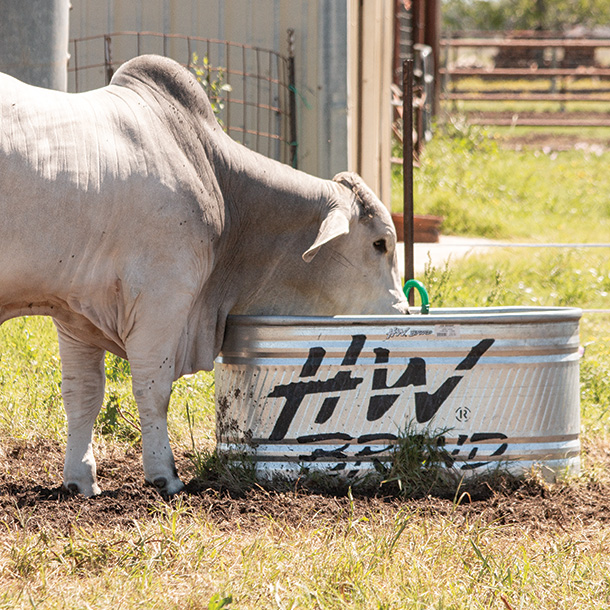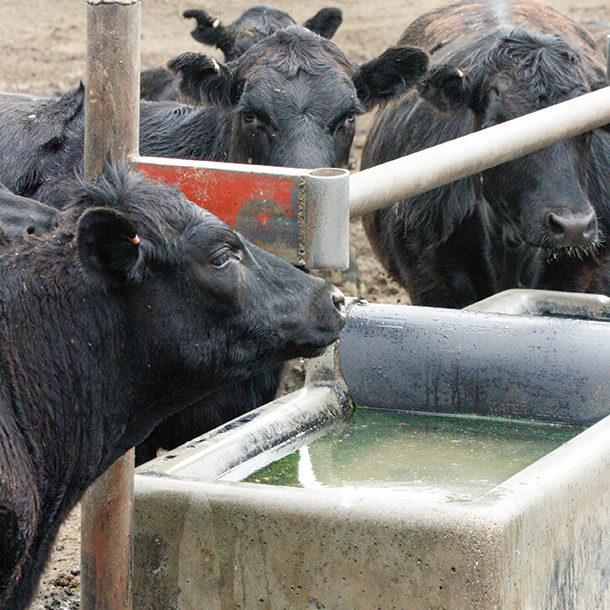Water is a required nutrient of all livestock; however, how often do you look at the quality of the water offered to your herd? You check the quality of forage and have your nutritionist balance your rations, but do you regularly investigate how the water quality changes throughout the year on your farm or even year to year?
In many parts of the U.S., rates of groundwater withdrawal are greater than those of recharge, resulting in decreased groundwater supplies and increased reliance on non-freshwater sources. Due to the lower recharge, there can be a change in the quality of the water you are giving your livestock. Low rainfall can cause an increase in total dissolved solids (TDS) in the soil and groundwater. The quality of water available for drinking can impact water consumption, dry matter intake (DMI) and production efficiency in livestock. Understanding the quality of the water your cattle are consuming is essential to their welfare and optimized production.
Taking water samples routinely is simple and can be done with very few supplies. Working with your local extension agent is one of the best ways to get the water on your land tested. He or she can also help recommend a change in diet or trace mineral supplementation based on the quality of water on your farm. Many minerals interact negatively and bind up other minerals (e.g., copper with zinc, sulfur with copper, etc.), creating deficiencies if proper supplementation isn’t implemented. It’s also important to note that water can vary from pasture to pasture, so taking samples from multiple water sources can help give a better picture of water quality on your land.
Step 1: Fill out the laboratory submission form and collect your sample collection kit (sample container, cooler, ice, gloves and shipping container).
Step 2: Find the location of where you should sample.
- If livestock drink from a trough/tank, take the sample after any water treatment but before the water is in trough/tank.
- If collecting from a farm pond, collect away from a spring and fully submerge the container in Step 5.
Step 3: Run the water for five minutes before collection (unless collecting from a pond).
Step 4: Rinse the container three times before collection.
Step 5: Fill the container to the top with the sample and screw the lid on tightly.
Step 6: Refrigerate the sample until it is sent to the laboratory.
 Staff photo.
Staff photo.
Note: If taking a sample for bacterial analysis, avoid contamination from your hands; do not touch the inside of the water container. Bacterial water samples need to be put on ice immediately and should stay on ice during shipping. For accurate results, the samples need to reach the laboratory quickly, so plan to send the samples early in the week to be run within the correct time frame.
When you receive your samples back, you will receive a range of information including levels of TDS, nitrate-nitrogen (NO3-N), boron, sulfate, sodium chloride and various other minerals. There are some that we know are more detrimental to cattle than others like sulfate, boron, and NO3-N. Use the following guide to compare your water samples and make sure nothing is out of the normal range for cattle.
1. TDS – Water with TDS less than 3,000 milligrams per kilogram (mg/kg) has historically been deemed safe for livestock consumption, and no negative side effects should be expected other than potential initial diarrhea.
- Up to 1,000 milligrams per liter (mg/L) is considered fresh water or safe water.
- From 3,000 to 5,000 mg/kg, diarrhea should be expected and intake may be suppressed, inhibiting maximum performance.
- From 5,000 mg/kg and greater, water should be avoided for pregnant and lactating animals.
- Anything beyond 7,000 mg/kg should be avoided entirely.
2. NO3-N – Less than 10 mg/kg of NO3-N is recognized as safe for beef cattle.
3. Sulfate – Sulfate can be detrimental to water intake and DMI, and general recommendations are less than 500 mg/L for calves and less than 1,000 mg/L for adult cattle.
4. Boron – The threshold for boron toxicity in livestock is 5 mg/L.
When you get your analysis back, take time and look over the new pieces of information; make sure to involve your extension agent, veterinarian, or nutritionist. Based on the analysis, there may be changes you need to implement, whether changing the composition of your mineral or utilizing the different water sources effectively. Water quality, just like forage quality, is going to vary year to year, so make sure to mark your calendars to revisit the different water sources next year to best maximize your herd’s performance.
References omitted but are available upon request. Click here to email an editor.








